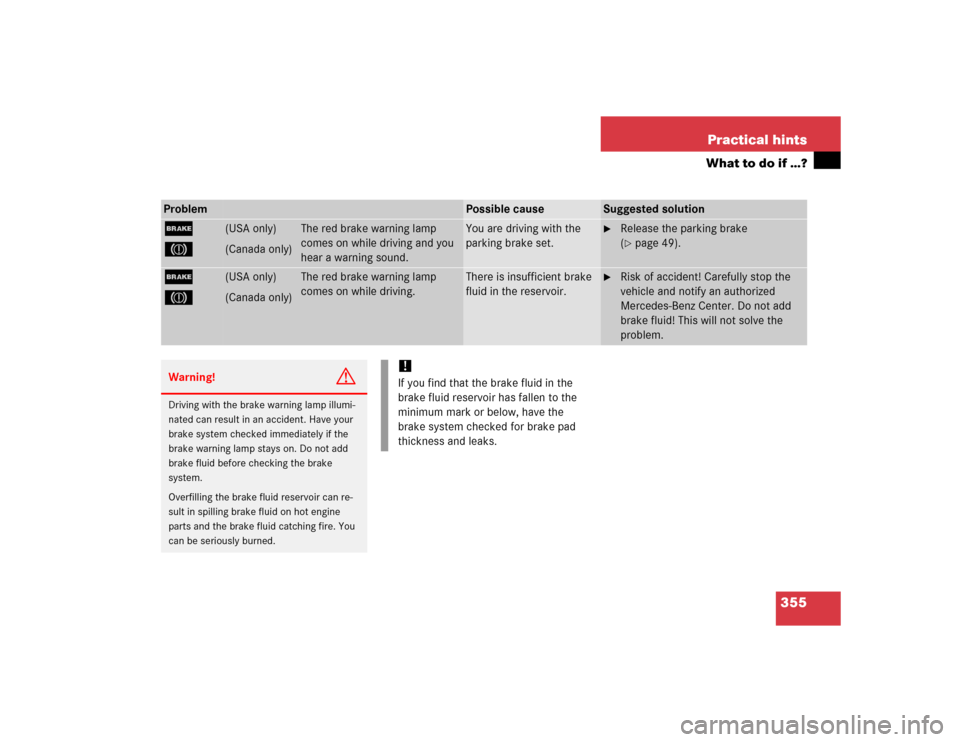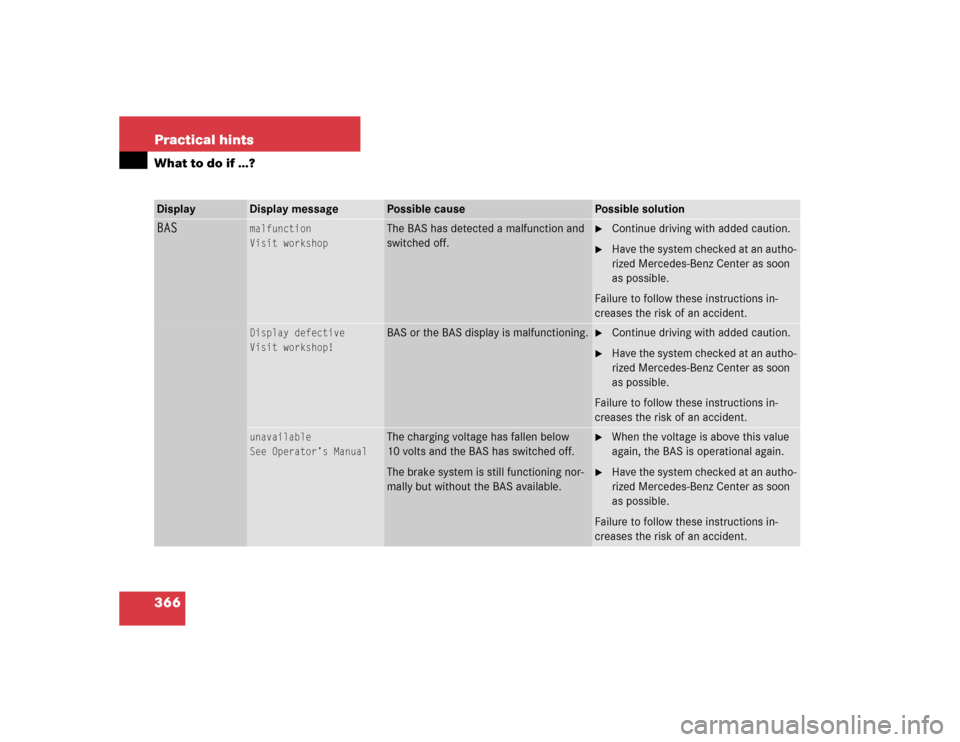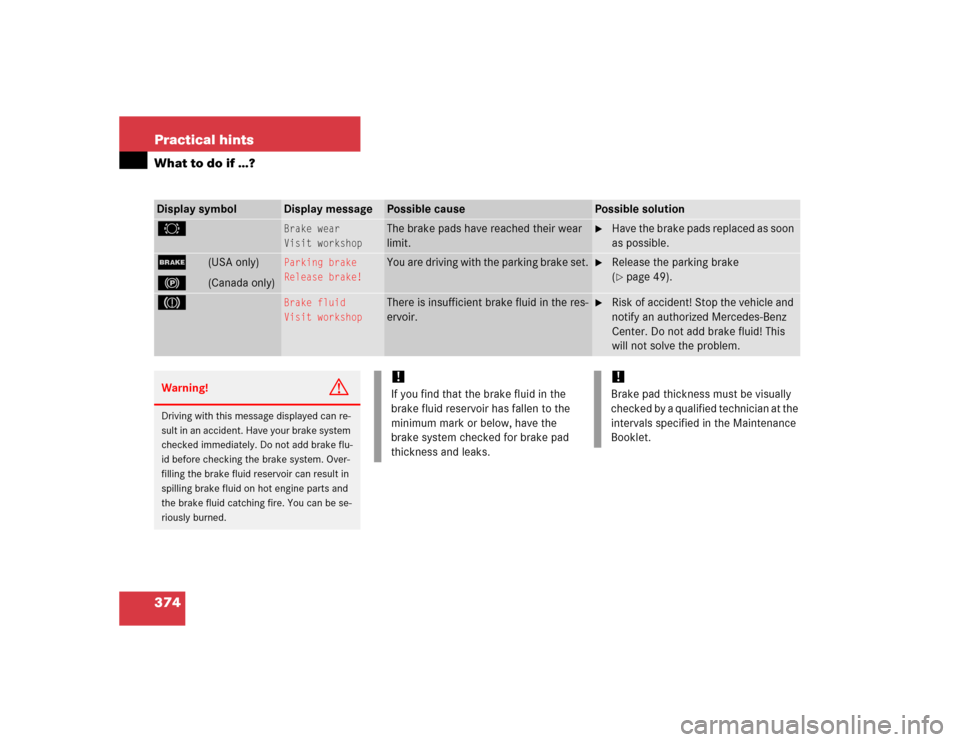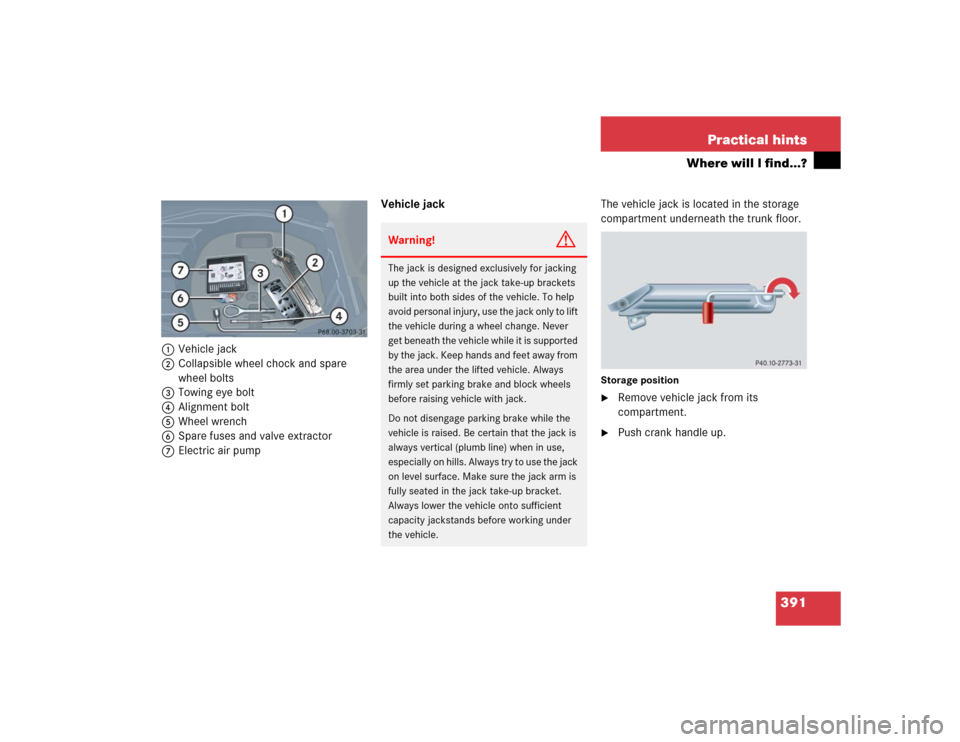Page 357 of 498

355 Practical hints
What to do if …?
Problem
Possible cause
Suggested solution
;
3
(USA only)
(Canada only)
The red brake warning lamp
comes on while driving and you
hear a warning sound.
You are driving with the
parking brake set.
�
Release the parking brake
(�page 49).
;
3
(USA only)
(Canada only)
The red brake warning lamp
comes on while driving.
There is insufficient brake
fluid in the reservoir.
�
Risk of accident! Carefully stop the
vehicle and notify an authorized
Mercedes-Benz Center. Do not add
brake fluid! This will not solve the
problem.
Warning!
G
Driving with the brake warning lamp illumi-
nated can result in an accident. Have your
brake system checked immediately if the
brake warning lamp stays on. Do not add
brake fluid before checking the brake
system.
Overfilling the brake fluid reservoir can re-
sult in spilling brake fluid on hot engine
parts and the brake fluid catching fire. You
can be seriously burned.
!If you find that the brake fluid in the
brake fluid reservoir has fallen to the
minimum mark or below, have the
brake system checked for brake pad
thickness and leaks.
Page 358 of 498

356 Practical hintsWhat to do if …?Problem
Possible cause
Suggested solution
?
±
(USA only)
(Canada only)
The yellow engine
malfunction indi-
cator lamp comes
on while driving.
There is a malfunction in:�
The fuel management system
�
The ignition system
�
The emission control system
�
Systems which affect emissions
Such malfunctions may result in ex-
cessive emissions values and may
switch the engine to its Limp-Home
Mode (emergency operation).
�
Have the vehicle checked as soon as possi-
ble by an authorized Mercedes-Benz Center.
An on-board diagnostic connector is used by
the service station to link the vehicle to the
shop diagnostics system. It allows the accu-
rate identification of system malfunctions
through the readout of diagnostic trouble
codes. It is located in the front left area of the
footwell next to the parking brake pedal.
A loss of pressure has been
detected in the fuel system. The fuel
cap may not be closed properly or
the fuel system may be leaky.
�
Check the fuel cap (
�page 305).
If it is not closed properly:
�
Close the fuel cap.
If it is closed properly:
�
Have the fuel system checked by an autho-
rized Mercedes-Benz Center.
Your fuel tank is empty.
�
After refuelling, start, turn off, and restart the
engine three or four times in succession.
The Limp-Home mode is canceled. You do not
need to have your vehicle checked.
Page 366 of 498
364 Practical hintsWhat to do if …?Text messagesDisplay
Display message
Possible cause
Possible solution
ABS
malfunction
Visit workshop
The ABS has detected a malfunction and
has switched off. The ESP and the BAS are
also deactivated.
The brake system is still functioning nor-
mally but without the ABS available.
�
Continue driving with added caution.
Wheels will lock during hard braking,
reducing steering capability.
�
Have the system checked at an autho-
rized Mercedes-Benz Center as soon
as possible.
Failure to follow these instructions in-
creases the risk of an accident.
Display defective
Visit workshop!
The ABS or the ABS display is malfunc-
tioning.
�
Continue driving with added caution.
Wheels will lock during hard braking,
reducing steering capability.
�
Have the system checked at an autho-
rized Mercedes-Benz Center as soon
as possible.
Failure to follow these instructions in-
creases the risk of an accident.
Page 367 of 498
365 Practical hints
What to do if …?
Display
Display message
Possible cause
Possible solution
ABS
Anti-lock
braking system
not working!
The charging voltage has fallen below
10 volts and the ABS has switched off.
The brake system is still functioning nor-
mally but without the ABS available.
�
When the voltage is above this value
again, the ABS is operational again.
�
Continue driving with added caution.
Wheels will lock during hard braking,
reducing steering capability.
�
Have the system checked at an autho-
rized Mercedes-Benz Center as soon
as possible.
Failure to follow these instructions in-
creases the risk of an accident.
Page 368 of 498

366 Practical hintsWhat to do if …?Display
Display message
Possible cause
Possible solution
BAS
malfunction
Visit workshop
The BAS has detected a malfunction and
switched off.
�
Continue driving with added caution.
�
Have the system checked at an autho-
rized Mercedes-Benz Center as soon
as possible.
Failure to follow these instructions in-
creases the risk of an accident.
Display defective
Visit workshop!
BAS or the BAS display is malfunctioning.
�
Continue driving with added caution.
�
Have the system checked at an autho-
rized Mercedes-Benz Center as soon
as possible.
Failure to follow these instructions in-
creases the risk of an accident.
unavailable
See Operator’s Manual
The charging voltage has fallen below
10 volts and the BAS has switched off.
The brake system is still functioning nor-
mally but without the BAS available.
�
When the voltage is above this value
again, the BAS is operational again.
�
Have the system checked at an autho-
rized Mercedes-Benz Center as soon
as possible.
Failure to follow these instructions in-
creases the risk of an accident.
Page 376 of 498

374 Practical hintsWhat to do if …?Display symbol
Display message
Possible cause
Possible solution
2
Brake wear
Visit workshop
The brake pads have reached their wear
limit.
�
Have the brake pads replaced as soon
as possible.
;
(USA only)
!
(Canada only)
Parking brake
Release brake!
You are driving with the parking brake set.
�
Release the parking brake
(�page 49).
3
Brake fluid
Visit workshop
There is insufficient brake fluid in the res-
ervoir.
�
Risk of accident! Stop the vehicle and
notify an authorized Mercedes-Benz
Center. Do not add brake fluid! This
will not solve the problem.
Warning!
G
Driving with this message displayed can re-
sult in an accident. Have your brake system
checked immediately. Do not add brake flu-
id before checking the brake system. Over-
filling the brake fluid reservoir can result in
spilling brake fluid on hot engine parts and
the brake fluid catching fire. You can be se-
riously burned.
!If you find that the brake fluid in the
brake fluid reservoir has fallen to the
minimum mark or below, have the
brake system checked for brake pad
thickness and leaks.
!Brake pad thickness must be visually
checked by a qualified technician at the
intervals specified in the Maintenance
Booklet.
Page 384 of 498

382 Practical hintsWhat to do if …?Display symbol
Display message
Possible cause
Possible solution
I
Key recognized
in vehicle!
A SmartKey with KEYLESS-GO* left in the
vehicle was recognized while locking the
vehicle from the outside.
�
Take the SmartKey out of the vehicle.
Key
do not forget key
This display appears (for a maximum of
60 seconds) if the driver’s door is opened
with the engine shut off and no SmartKey
in the starter switch.
Message is only a reminder.
�
Insert SmartKey in the starter switch.
�
Take the SmartKey with
KEYLESS-GO* with you when leaving
the vehicle.
.
3rd brake lamp
The high mounted brake lamp is malfunc-
tioning.
�
Visit an authorized Mercedes-Benz
Center as soon as possible.
Brake lamp
Drive to workshop
Stop lamp illumination is delayed or lamp
is permanently on.
�
Visit an authorized Mercedes-Benz
Center as soon as possible.
Brake lamp, left
The left brake lamp is malfunctioning.
�
Visit an authorized Mercedes-Benz
Center as soon as possible.
Brake lamp, right
The right brake lamp is malfunctioning.
�
Visit an authorized Mercedes-Benz
Center as soon as possible.
Display malfunction
Visit workshop
The display for the lamps or the system is
malfunctioning.
�
Visit an authorized Mercedes-Benz
Center as soon as possible.
Front foglamp, left
The left front fog lamp is malfunctioning.
�
Replace the bulb as soon as possible.
Front foglamp, right
The right front fog lamp is malfunctioning.
�
Replace the bulb as soon as possible.
Page 393 of 498

391 Practical hints
Where will I find...?
1Vehicle jack
2Collapsible wheel chock and spare
wheel bolts
3Towing eye bolt
4Alignment bolt
5Wheel wrench
6Spare fuses and valve extractor
7Electric air pumpVehicle jackThe vehicle jack is located in the storage
compartment underneath the trunk floor.
Storage position�
Remove vehicle jack from its
compartment.
�
Push crank handle up.
Warning!
G
The jack is designed exclusively for jacking
up the vehicle at the jack take-up brackets
built into both sides of the vehicle. To help
avoid personal injury, use the jack only to lift
the vehicle during a wheel change. Never
get beneath the vehicle while it is supported
by the jack. Keep hands and feet away from
the area under the lifted vehicle. Always
firmly set parking brake and block wheels
before raising vehicle with jack.
Do not disengage parking brake while the
vehicle is raised. Be certain that the jack is
always vertical (plumb line) when in use,
especially on hills. Always try to use the jack
on level surface. Make sure the jack arm is
fully seated in the jack take-up bracket.
Always lower the vehicle onto sufficient
capacity jackstands before working under
the vehicle.